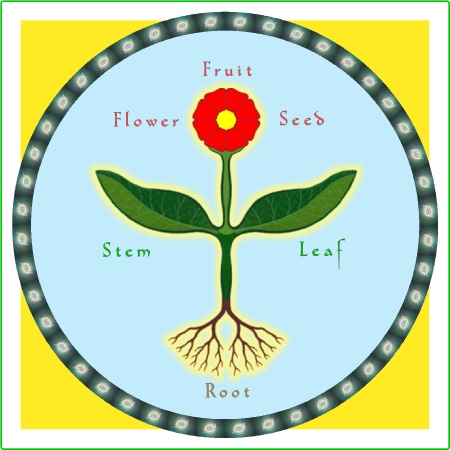

Further Stage of Threefold Principle

Introductory Reading:
THE USE OF TRANSITIONAL & ADDITIONAL CATEGORIES
When we start to observe the manifestations of the archetype of the threefold plant in the natural world we are forced to develop more flexible – one could even say more fluid – thinking. For although there are many plants with clear threefold structure, there are also those where things have shifted, or they exist somewhere between two states of existence. For example, garlic and onions – two vegetable staples of many food cultures – are swollen stems growing in the earth, as is the case with the roots. This means that according to the threefold principle they should be regarded as a Stem-Root. This means that one can count them as Stem or Root when you compose a dish according to this principle. However, by means of observation of typical characteristics of specific groups we can figure out which influence is stronger. The existence of such vegetables might be experienced as a difficulty, or as the open space for more creativity in balancing the dish or the whole meal.
♣ For more
transitional vegetables
see THREE GROUPS OF VEGETABLES
Another example is the seaweed used in cooking, such as agar, dulse, kelp, kombu, nori, etc. Seaweeds are plants which do not have flowers; they are as a matter of fact floating leaves fastened to the rocks by small roots. Although they are leaves, they have a different quality than ordinary plant leaves. For that reason we don't count them as leaf element when we make a dish according to the principle of the threefold plant. However, their use as additional ingredients can bring a completely new range of sensory experiences and many nutriments which we might lack in other food ingredients. If we wish we can considerably enrich our daily meals with seaweeds.
The next example is the mushroom which are an essential part of the plant kingdom [1] for they enable recycling of the fibrous parts of plants (wood, bark, etc.) back into the life cycle. The edible mushrooms are in fact fruit parts of the network of 'root-like' mycelium threads underground. They are not capable of photosynthesis which is the essential activity of plant leaves. However, they live in symbiotic relationships with plants which provide them with carbohydrates which are formed in their leaves. From this description it is obvious that we have a kind of unusual root-fruit combination without any leaves. The function of leaves is performed for them by plants through symbiotic relationship. For that reason we can use them as an addition (or even as substitute for meat), but we do not count them when we compose a dish in accordance with the principle of the threefold plant. With the help of mushrooms we can easily create dishes with full-bodied and attractive flavours that can enrich our menu.
ADVANCED BALANCING WITH DRIED HERBS & SPICES
There are some spices which came from the root parts of a plant (e.g. ginger powder) and some made from the bark of a tree (e.g. cinnamon). Only these spices can be regarded as 100% Root. [2] This is also the case with natural salt and other mineral additives used in cooking.
Then we have spices which originate from the flowers or fruits or seeds of the plants. These spices have gone through the process of contraction and mineralisation as is evident if we observe the seeds of pepper or caraway, etc. In the case of fruit parts such as sweet peppers and chillies the same process has been caused by drying. This is the reason why we count them as Root – with an addition of Flower-Fruit-Seed (because they all at least went through the flowering process). This enables us to use them when we lack in the specific dish the ingredients belonging to the upper part of the plant. For example, we can prepare a simple dish with wholemeal bread, cheese or fried tofu, and salad made from:
If we were using dried herbs instead of pepper (or any other spice which originates from the upper part of the plants), we would lack in the dish the Flower-Fruit-Seed element. Of course, with the addition of a little oil we could get it, but this example illustrates that there exists also the possibility to achieve a similar result with the proper use of spices.
A similar case is with dried herbs. Only when we use fresh herbs can we count them as 100% Leaves. Through the process of drying they have become mineralised to such a degree that we need to place them into the Root group with an addition of LEAF element (because they still contain specific characteristics of leaves). For that reason we can use them when we do not have available any fresh herbs or leafy vegetables. For example, we can stir-fry the following simple dish which can be consumed with wholemeal bread (and if you wish with some cheese):
This is better than using other spices instead of dried herbs (such as fennel, coriander, etc.) which would leave the dish without any trace of the Leaf element. The best idea would be to balance such a dish with a salad with leafy vegetables (e.g. lettuce, sauerkraut, etc), but sometimes circumstances don't allow us these sort of solutions. In such cases we can help ourselves by the use of herbs and spices in the manner described above.
In addition to this we can use the mixtures which contain herbs and spices belonging to more than one group such us Chinese five spice, herb salt, gomasio (Japanese sesame salt), etc. The use of such mixtures is often helpful in the preparation of dishes in accordance with the principle of the threefold plant.

♦ For the origins of the main dried herbs and spices
see
THREE SUBGROUPS OF DRIED HERBS & SPICES
NOTES